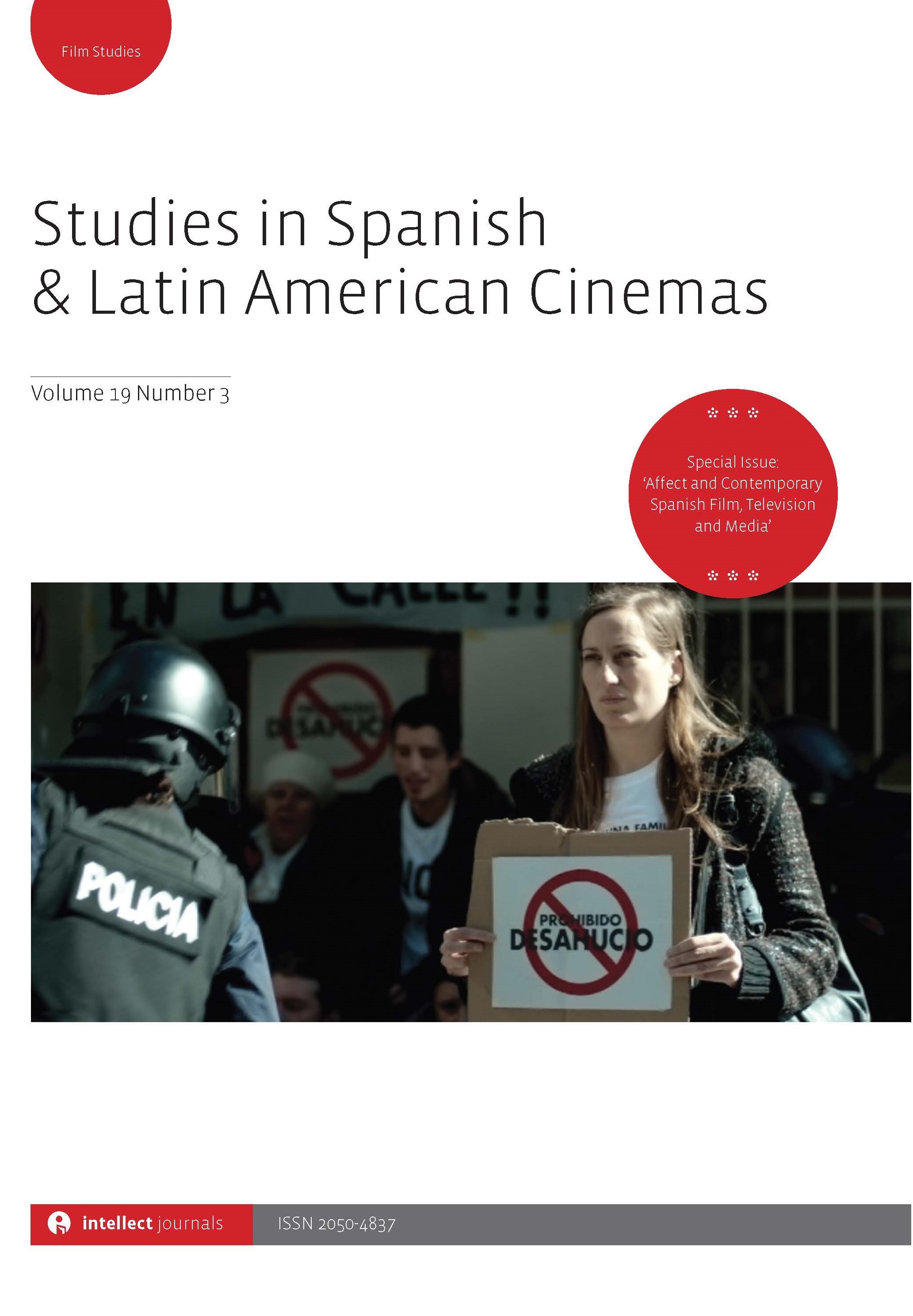- Home
- A-Z Publications
- Studies in Spanish & Latin American Cinemas
- Previous Issues
- Volume 11, Issue 3, 2014
Studies in Spanish & Latin American Cinemas - Volume 11, Issue 3, 2014
Volume 11, Issue 3, 2014
-
-
Entertainment venues, spatial relations and the rise of cinema in early twentieth-century Madrid
More LessBy Luis GuadanoAbstractBy the turn of the twentieth century, the geography of public entertainment in Madrid allowed and promoted the flow of audiences from high-class theatres and cafes to lower-class venues. As a result, theatres and movie theatres started copying and including successful elements and acts from competing shows to attract the audience. This article will focus on two elements which set the conditions for the rise of Spanish film as hegemonic spectacle: the spatial proximity of different entertainment options in downtown Madrid and the creation of a homogeneous audience through the erasure of differences between venues and shows due to the competition for spectators. Within this context and through the adaptation and incorporation of elements from other popular and successful genres, Spanish film will establish itself as an independent spectacle, with its own strategies of representation and venues, in the early 1930s.
-
-
-
The politics of looking in Fernando León de Aranoa’s Princesas (2005)
More LessAbstractFernando León de Aranoa’s critically acclaimed film Princesas (2005) shows the friendship that forms between a Dominican and a Spanish prostitute in twenty-first century Madrid. In order to theorize alterity in contemporary Spanish culture, this essay analyses the cinematic formulation of the gaze that nationals commonly cast upon immigrants and its inverse, namely, constructions of (in)visibility. By focusing on the question of cinematic gaze, I will show that Princesas not only explores immigration in twenty-first century Spain but also attempts to reformulate the way the audience visualizes immigration by presenting the chief protagonists in their invisibility – along with the attendant vulnerability this invisibility engenders – as other characters evade, objectify or silence them. Hence, the spectator does not just view the body of an ‘other’ – as it is fragmented, exoticized or abused – but the dangerous consequences of Otherness.
-
-
-
De la resistencia al duelo: las ficciones sobre las dictaduras realizadas en Argentina y Chile entre 1973 y 1990/From resistance to mourning: The fiction films about dictatorships made in Argentina and Chile between 1973 and 1990
More LessAbstractAllegorical and metaphorical fiction has been a highly productive tendency in Chilean and Argentinean film-making during the recent military dictatorships in both countries. The main goal of this article is to understand the dimensions and characteristics of this tendency in recent years. Its specific goals are to identify and analyse two different variants of this tendency, each of which is definable in relation to the deployment of the narrative system and the mise-en-scène; to analyse the ways in which fiction films about dictatorships sought to denounce and resist the social norms and practices instituted by the de facto governments of Argentina and Chile.
-
-
-
Helena Lumbreras’ Field for Men (1973): Midway between Latin American Third Cinema and the Barcelona School
More LessAbstractIn 1973, Barcelona-based film-makers Helena Lumbreras and Mariano Lisa made a clandestine documentary called Field for Men (El campo para el hombre), which denounced the dismal conditions in rural Spain under Franco’s dictatorship, foregrounding the need for agrarian reform and land redistribution. The film is executed in a style midway between militant Third Cinema and 1960s European experimental and art cinemas. On account of her interstitial position between European ‘Second Cinema’ and Latin American ‘Third Cinema’, Lumbreras articulated a hybridized counter-ideological cinema that integrated experimentalism and political commitment. This article examines how Field for Men bridges both documentary and experimental genres, while expressing the need for economic, political and formal liberation. Additionally, it argues that Lumbreras’ intermediality is a political manoeuvre that associates, on a formal level, the concepts of medium purity and specificity as socially alienating, while aligning medium hybridity with utopian dreams of liberation.
-
-
-
Lethal franchise: The evolution of the Torrente saga (1998–2011)
More LessBy Barry JordanAbstractThe so-called Torrente saga (1–4, 1998–2011), written, directed and partly co-produced by Santiago Segura, has become the most commercially successful franchise in Spain’s entire film history. With four instalments to date (and a fifth now scheduled for release in October 2014), these trash comedy films have so far attracted over 14.5 million local admissions and over 71 million euros in domestic box office, not counting ancillary revenues (source mcu.es). Compared to dominant, taxpayer-subsidized, art film productions, which evoke very little spectator appeal and remain almost entirely loss making, Segura’s audiences and grosses constitute outstanding, indeed unique, commercial achievements. In this article, my main aim is to explain why the Torrente franchise has been so popular and consistently successful, at least in Spain (though much less so internationally). At the same time, given that the Torrente phenomenon reflects important developments taking place in the marketing, exhibition and consumption of recent Spanish cinema, this article will explore the franchise as a case study of these changes.
-
-
-
Book Reviews
More LessAuthors: Lisa Shaw, Jorge Pérez, Antonio Lázaro-Reboll and Dr Niamh ThorntonAbstractNew Argentine and Brazilian Cinema: Reality Effects, Jens Andermann and Álvaro Fernández Bravo (eds) (2013) New York: Palgrave Macmillan, 228 pp., ISBN 978-1-137-30482-7 (hbk), £57.50
Spanish Queer Cinema, Chris Perriam (2013) Edinburgh: Edinburgh University Press, 192 pp., ISBN 978-07486-6586-0 (hbk), £65
Spanish Practices: Literature, Cinema, Television, Paul Julian Smith (2012) Oxford: Legenda, x + 166 pp., ISBN 978-1-907975-04-2 (hbk), £45
Screening the Americas/Proyectando las Américas: Narration of Nation in Documentary Film/Narración de la nación en el cine documental, Josef Raab, Sebastian Thies and Daniela Noll-Opitz (eds) (2011) Trier, Germany and Tempe, Arizona: Wissenschaftlicher Verlag Trier and Bilingual Press/Editorial Bilingue, 460 pp., ISBN 978-3868213317, EUR 29.50 (pbk)
-
Most Read This Month


